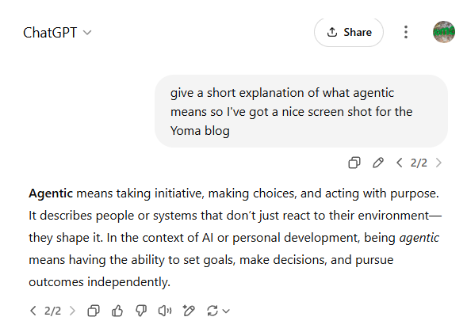Workwear Trends Driving Growth in 2025
As we move through 2025, the global workwear industry continues to experience strong momentum. With a projected annual growth rate...

AI is unavoidable having thoroughly bled over into real life now, but aside from the productivity and generative image trends, what’s the actionable insights that will set better foundations for the future of ecommerce.
Visitor volumes from search are dropping. That can, in part, be attributed to AI overviews (AIO) in search results, but will also be a factor of users turning to AI as means of discovery i.e. using AI chatbots as search engines.
As was discussed at HiveMCR last week, this currently means the downstream traffic from search engines is increasing in relevance and value.
Is this because users who turn to search engines are far further down the funnel, or is the demographic of search engines skewing to more affluent (read: older) users with more disposable income and propensity to buy? (We saw similar patterns between Google and Bing users a decade ago).
AIO is just another variation of the Zero click results we contend with on “people also ask” (PAA) and knowledge box results, but the content appears to be far more effective at answering user queries and less likely to result in a click to a site.
AIO was tracked as appealing around 18% of the time in the UK and 13% in the US (SEMRush), but increasing rapidly. This is heavily focused on informational queries, more typically seen as higher funnel, lower conversion activity.
It would be tempting to target content placement in the AIO through an SEO strategy, given it was a productive tactic for knowledge box and “people also ask”, but the likelihood of recognition or a click from AIO is lower.
A balanced keyword strategy including keywords throughout the user journey from the high funnel, informational to the low funnel transactional and navigational will offer the best return.
For this, keyword research is as critical as ever and absolutely not be trusted to your favored AI chat bot!

For ecommerce merchants, getting converting traffic to the site has been the focus. What if converting traffic doesn’t even need to get to your site?
Shopify and ChatGPT have already rolled out their integration and at Google I/O this week talked about “check out inside search”. Both solutions suggest a user only having to communicate with their chosen bot which will then do the leg work for them.
At Big Summit, BigCommerce annual conference, Piers Linny preached the virtues of letting your personalised AI agent choose your next BBQ purchase without asking for much more than pay the bill.
To many, this may seem like a surrender of too much power, choice or even fun, but we cannot underestimate the expectations of future generations. Every generation has an increased anxiety about human interaction to the point at as many as 25% of Gen Z won’t answer a ringing phone. For people to cede interactions, especially mundane ones to a bot does not seem like a stretch.
This feels a far more precarious point for ecommerce retailers, albeit one further in the future.
Will a website matter? Yes, but not perhaps in the same way it does now. Sites will become a connection point not just for users, but for bots. The color of checkout buttons will be less impactful, but the data structure, the compatibility and connectivity will. And the ecommerce data strategy is where success will be found.
The outbound data, much like the structured data we have focused on for SEO, will be critical. This in part is why Shopify and the relationship with ChatGPT is a significant win for them. They have established an out of the box integration.
Other tools such as Feedonomics from BigCommerce and Kyklo, an Epicor product can fulfil this critical integration and distribution of data.
Inbound data is the other side of the coin. Transactional data and first party knowledge of your customers will be even more important than ever. Similar to those industries governed by aggregators (e.g. Insurance and travel), retailers and distributors need to have a strategy to leverage their own data for the renewal, the repeat custom and retention. This will increase the direct interaction, but also provide critical signals to the bots and the humans they serve!
If you want to discuss any of the thoughts or strategies covered in this blog, get in touch or sign up to our newsletter below.
As we move through 2025, the global workwear industry continues to experience strong momentum. With a projected annual growth rate...
In the ever-evolving world of digital marketing, knowledge isn’t just power – it’s performance. As competition heats up in every...
As a partner that’s been deeply involved with Epicor Prophet 21 (P21) over the past two years, we are genuinely...
As the digital landscape continues to evolve in response to user privacy expectations and regulatory pressures, businesses using Google Ads...
In an era where data privacy regulations are tightening and user transparency is a priority, digital marketers are navigating an...
YOMA Attend HIVE Manchester 2025 Hive Manchester 2025 is back, and we attended the second-ever HiveMCR conference on May 15th,...

Our full-service digital agency can help you realise your vision. No matter what your industry, we see your potential and can build eCommerce solutions that will grow and scale with you.